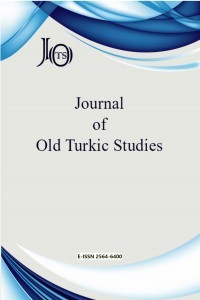Uygurlarda Maniheizm Etkisi Altında Gelişen Din-Devlet İlişkisi
In this paper, the relationship of state and religion in Manichaean Uygurs’ will be investigated based on the recent studies performed on Uygur material culture, including Manichaean texts and images. This work should be mostly treated as a general review summarizing and interpreting the latest discussions and findings on the presented topic. It will be further put in evidence by a wall painting depicting powerful Uygur Manichaean community and famous miniature showing probably the conversion scene of an important figure, mostly accepted as Bögü Qaγan.
Anahtar Kelimeler:
Uygurs, Manichaeism, state, religion, relationship
The Relationship of State and Religion Developed under Manichaeism’s Influence in Uygurs
In this paper, the relationship of state and religion in Manichaean Uygurs’ will be investigated based on the recent studies performed on Uygur material culture, including Manichaean texts and images. This work should be mostly treated as a general review summarizing and interpreting the latest discussions and findings on the presented topic. It will be further put in evidence by a wall painting depicting powerful Uygur Manichaean community and famous miniature showing probably the conversion scene of an important figure, mostly accepted as Bögü Qaγan.
Keywords:
Uygurs, Manichaeism, state, religion, relationship,
___
- BANG, W.; A. von GABAIN (1929). Türkische Turfan-Texte: II, Manichaica, Berlin. (Sitzungsberichte der Preußischen Akademie der Wissenschaften, Phil.-hist. Kl. 1929: 22, 411-430)
- CLARK, L. (2000). “The Conversion of Bügü Khan to Manichaeism”, Studia Manichaica: IV. Internationaler Kongreß zum Manichäismus (Berlin, 14-18 Juli 1987), Ed. R.E. EMMERICK et al, Akademie Verlag, Berlin: 83-123.
- DE LA VAISSIERE, É. (2005). Sogdian Traders: a History, Translated by J. WARD, Leiden-Boston: Brill.
- DROMPP, M. R. (2005). Tang China and The Collapse of Uighur Empire, a Documentary History, Leiden-Boston: Brill.
- ESİN, E. (1978). İslâmiyet’ten Önceki Türk Kültür Tarihi ve İslâm’a Giriş, (Türk Kültürü El-Kitabı, II, Cild I/b’den Ayrı Basım), İstanbul: Edebiyat Fakültesi Matbaası.
- GULÁCSI, Z. (2001). Manichean Art in Berlin Collection, Turnhout: Brepols.
- GÜNGÖR, H. (1994). “Uygur Kağan Unvanlarında Kün ve Ay Teñri Kavramlarının Kullanılışı”, XI. Türk Tarih Kongresi (Ankara, 5-9 Eylül 1990), Kongreye Sunulan Bildiriler, C. 2, Türk Tarih Kurumu Basımevi, Ankara: 511-517.
- HAMILTON, J. (1955). Les Ouïghours à l’époque des Cinq Dynasties: d’après les documents chinois, Paris: Impr. Nationale.
- HAMILTON, J. (1975). “Le Colophone de l’ïrq Bitig”, Turcica, 7: 7-19.
- İNAN, A. (1976). Eski Türk Dînî Tarihi, İstanbul: Millî Eğitim Basımevi.
- KİTAPÇI, Z. (2004). Doğu Türkistan ve Uygur Türkleri Arasında İslâmiyet: Tanrı Dağlarının Eteklerinde Yükselen İlk Tekbir ve Ezan Sesleri, Konya: Yedikubbe Yayınları.
- KLIMKEIT, H.-J. (1982). “Manichaean Kingship: Gnosis at Home in the World”, Numen, 29/1: 17-32.
- KLIMKEIT, H.-J. (1993). Gnosis on the Silk Road: Gnostic Texts from Central Asia, San Francisco-California: HarperSanFrancisco.
- KLYASHTORNYJ, S. G. (2000). “Manichean Monastries in the Land of Argu”, Studia Manichaica: IV. Internationaler Kongreß zum Manichäismus (Berlin, 14-18 Juli 1987), Ed. R.E. EMMERICK et al, Akademie Verlag, Berlin: 374-379.
- LE COQ, A. von (1911). Türkische Manichaica aus Chotscho I, Berlin. (Abhandlungen der Königlich Preußischen Akademie der Wissenschaften, Phil.- hist. Cl. 1911, Anhang: Abhandlungen nicht zur Akademie gehöriger Gelehrter, 6)
- LE COQ, A. von (1922). Türkische Manichaica aus Chotscho III, Nebst einem christlichen Bruchstück aus Bulayïq, Berlin. (Abhandlungen der Preußischen Akademie der Wissenschaften, Phil.-hist. Kl. 1922, 2)
- LIEU, S. N. C. (1979). Polemics Against Manichaeism as a Subversive Cult in Sung China (A.D.c. 960-c. 1200), Manchester: John Rylands University Library of Manchester.
- MACKERRAS, C. (1972). The Uighur Empire (744-840) According to T’ang Histories, a Study in Sino-Uighur Relations (744-840), Columbia: University of South Carolina Press.
- MACKERRAS, C. (2009). “Uygurlar”, Erken İç Asya Tarihi, Çev. Ş. TEKİN, Ed. D. SINOR, 5. Baskı, İletişim Yayınları, İstanbul: 425-458.
- MENSCHING, G. (2012). Din Sosyolojisi. Din, Kültür ve Toplum İlişkileri. Çev. M. AYDIN, 3. Baskı, Konya: Litera-Türk.
- MORIYASU, T. (2015). “New Developments in the History of East Uighur Manichaeism”, Open Theology, 1: 316-333.
- MÜLLER, F. W. K. (1910). Uigurica II, Berlin. (Abhandlungen der Preußischen Akademie der Wissenschaften, Phil.-hist. Cl. 1910: 3)
- ÖLMEZ, M. (2012). Orhon-Uygur Hanlığı Dönemi Moğolistan’daki Eski Türk Yazıtları, Metin-Çeviri-Sözlük, Ankara: BilgeSu Yayınları.
- SARIKÇIOĞLU, E. (2002). Başlangıçtan Günümüze Dinler Tarihi, 5. Baskı, Isparta: Fakülte Kitabevi.
- TANYU, H. (1978). Türklerin Dinî Tarihçesi, İstanbul: Türk Kültür Yayınları.
- TARDIEU, M. (2008). Manichaeism, Translated by M. B. DEBEVOISE, Urbana-Chicago: University of Illinois Press.
- TEZCAN, M. (2005). “Eski Türklerde Budizm Örneğine Göre Din-Devlet İlişkileri (IV.-V. Yüzyıllarda Kuzey Çin’deki ‘Yabancılar’)”, XIV. Türk Tarih Kongresi (Ankara, 9-13 Eylül 2002), Kongreye Sunulan Bildiriler, C. 1, Türk Tarih Kurumu Yayınları, Ankara: 113-173.
- ZEREN, M. E. (2015). Maniheizm ve Budizm’in Uygurların Kültür Hayatına Etkileri, İstanbul Üniversitesi, Sosyal Bilimler Enstitüsü, Türkiyat Araştırmaları Anabilim Dalı, İstanbul. (Yayımlanmamış Doktora Tezi)
- ZIEME, P. (1975). “Ein uigurischer Text über die Wirtschaft manichäischer Klöster im uigurischen Reich”, Researches in Altaic Languages, Ed. L. LIGETI, Akadémiai Kiadó, Budapest: 331-338.
- ZIEME, P. (1975). Manichäisch-türkische Texte: Texte, Übersetzung, Anmerkungen, Berliner Turfantexte 3, Berlin: Akademia Verlag.
- ZIEME, P. (1989). “Titulaturen und Elogen uigurischer Könige”, Religious and Lay Symbolism in the Altaic World and Other Papers, Proceedings of the 27th meeting of the PIAC, Ed. K. SAGASTER, Wiesbaden: 443-450.
- ZIEME, P. (2000). “Das uigurische Königreich von Qočo”, History of the Turkic Peoples in the Pre-Islamic Period, Ed. H. R. ROEMER, Klaus Schwarz Verlag, Berlin: 205-212.
- Yayın Aralığı: Yılda 2 Sayı
- Başlangıç: 2017
- Yayıncı: Erdem UÇAR
